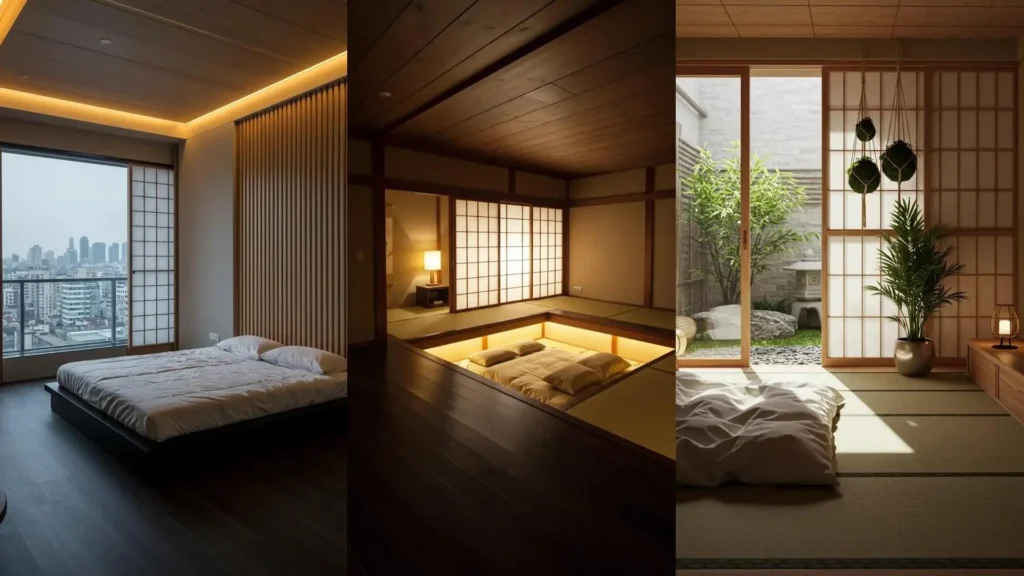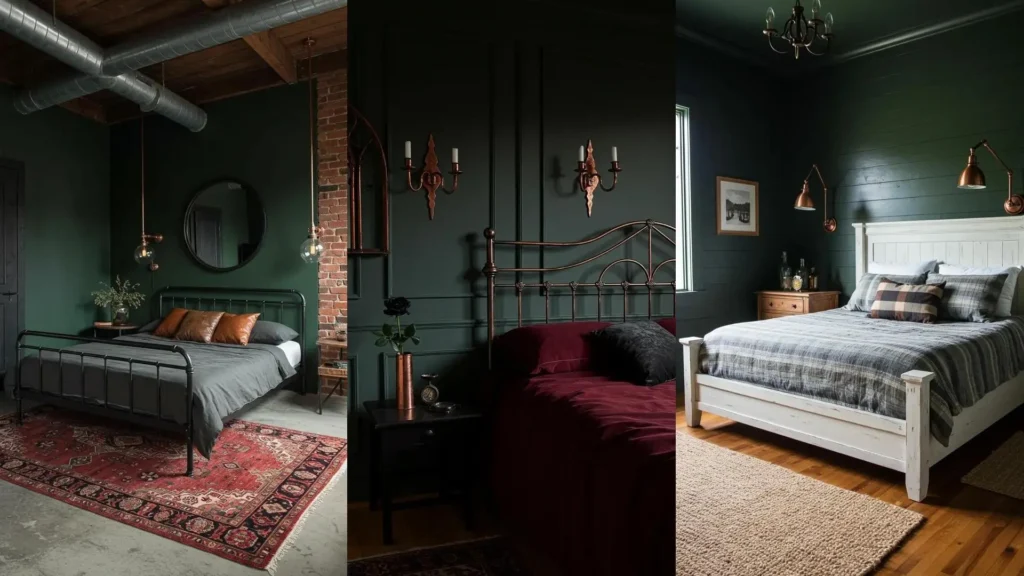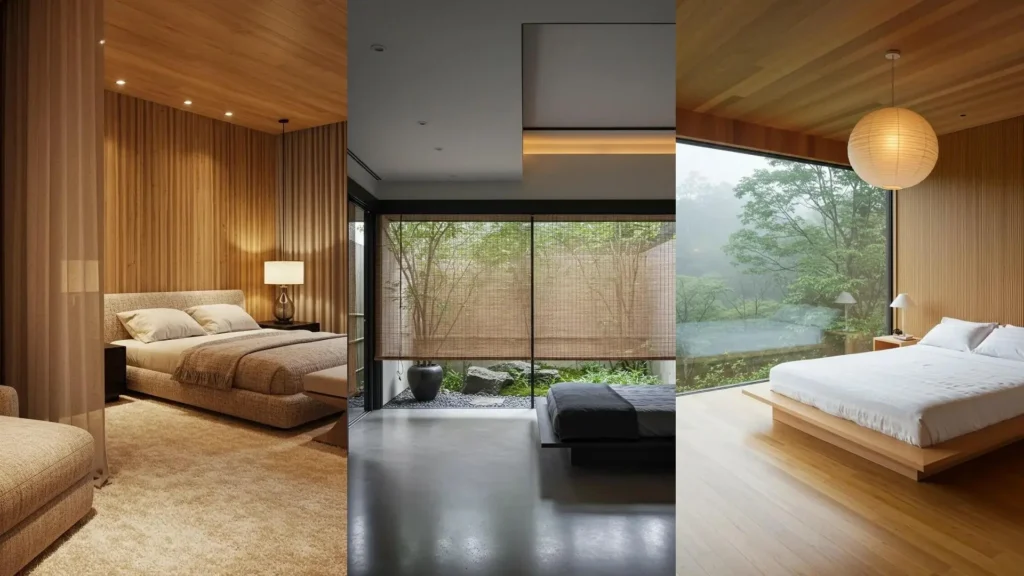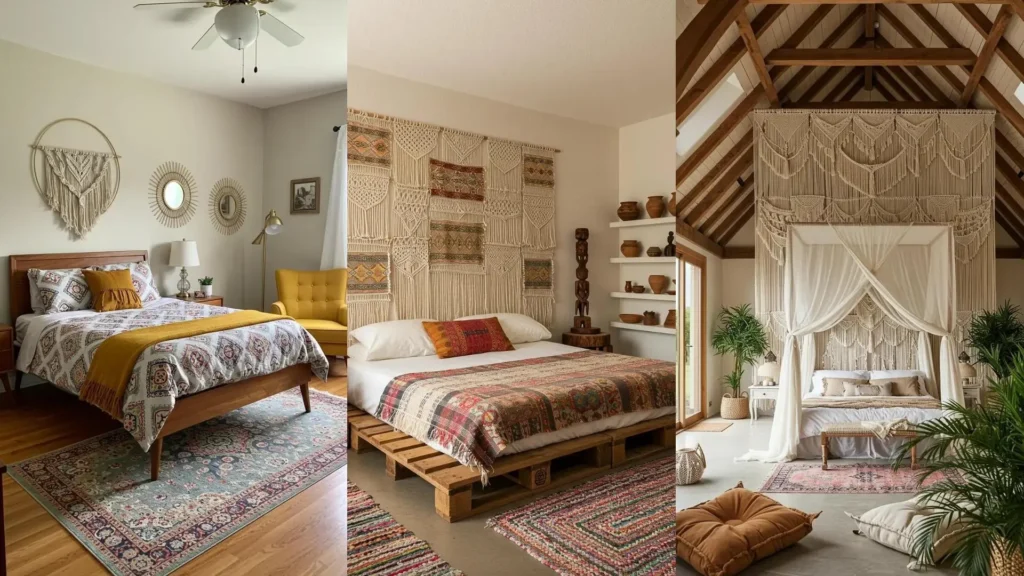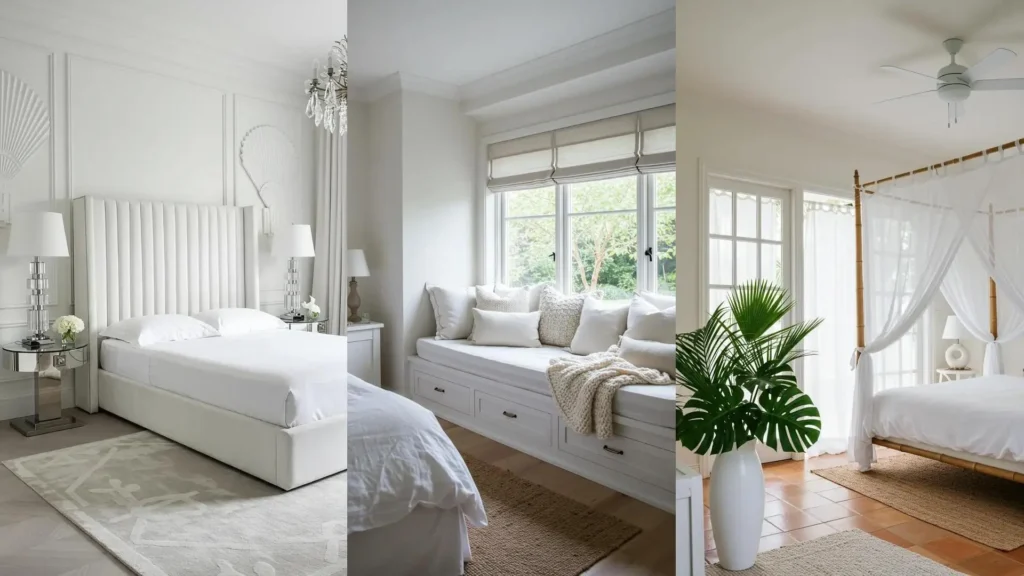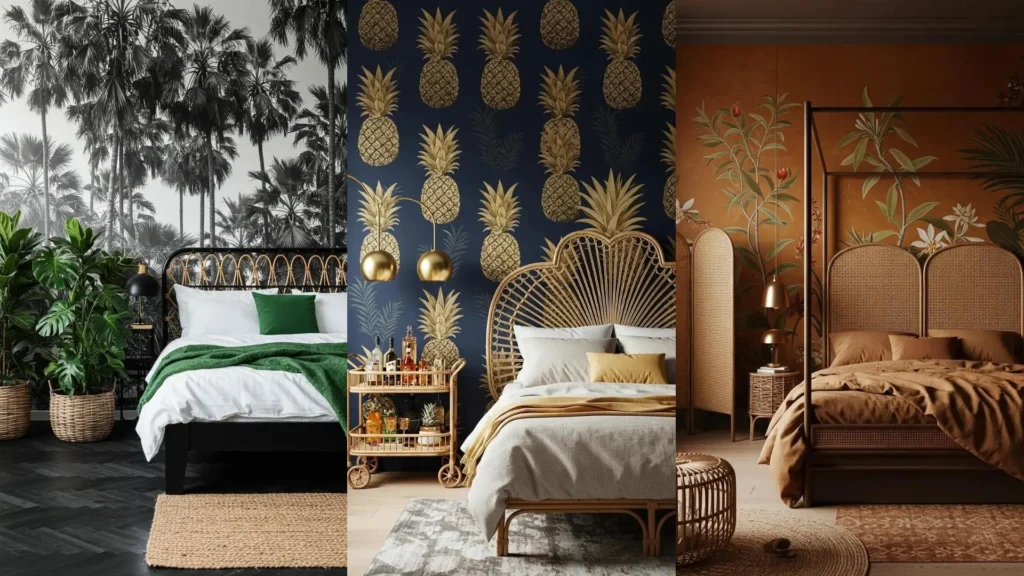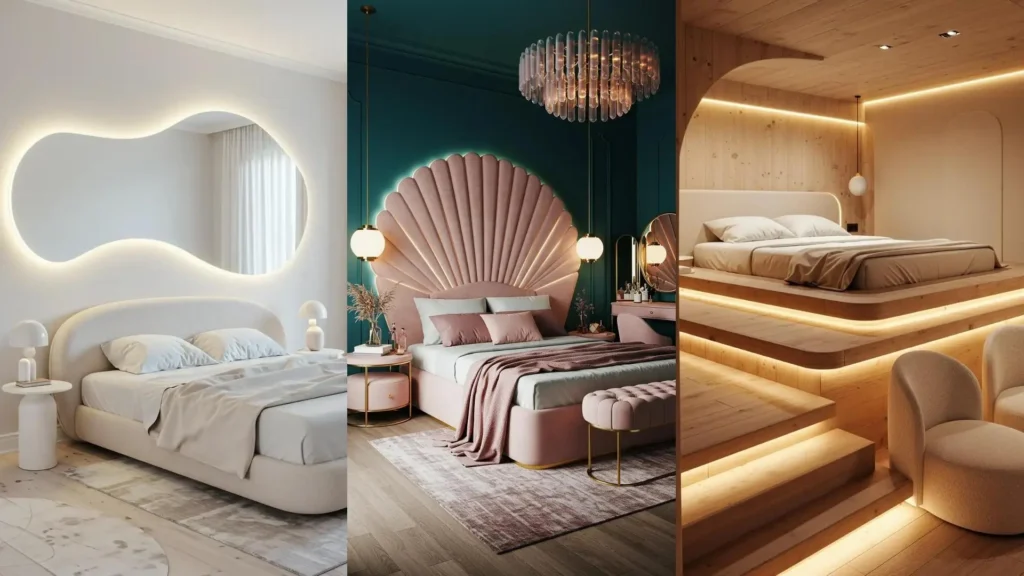Your bedroom should be more than just a place to sleep; it should be a sanctuary—a space that calms your mind and restores your spirit from the moment you step inside.
The principles of Japanese design offer a beautiful framework for creating this kind of peace. It’s not about rigid rules, but about a philosophy that values simplicity, natural materials, and the thoughtful use of light and space.
Here, you’ll find actionable ideas to help you craft a bedroom that feels intentional, serene, and deeply personal. It’s about cultivating tranquility, one careful choice at a time.
1. Embrace the Grounded Bed Frame
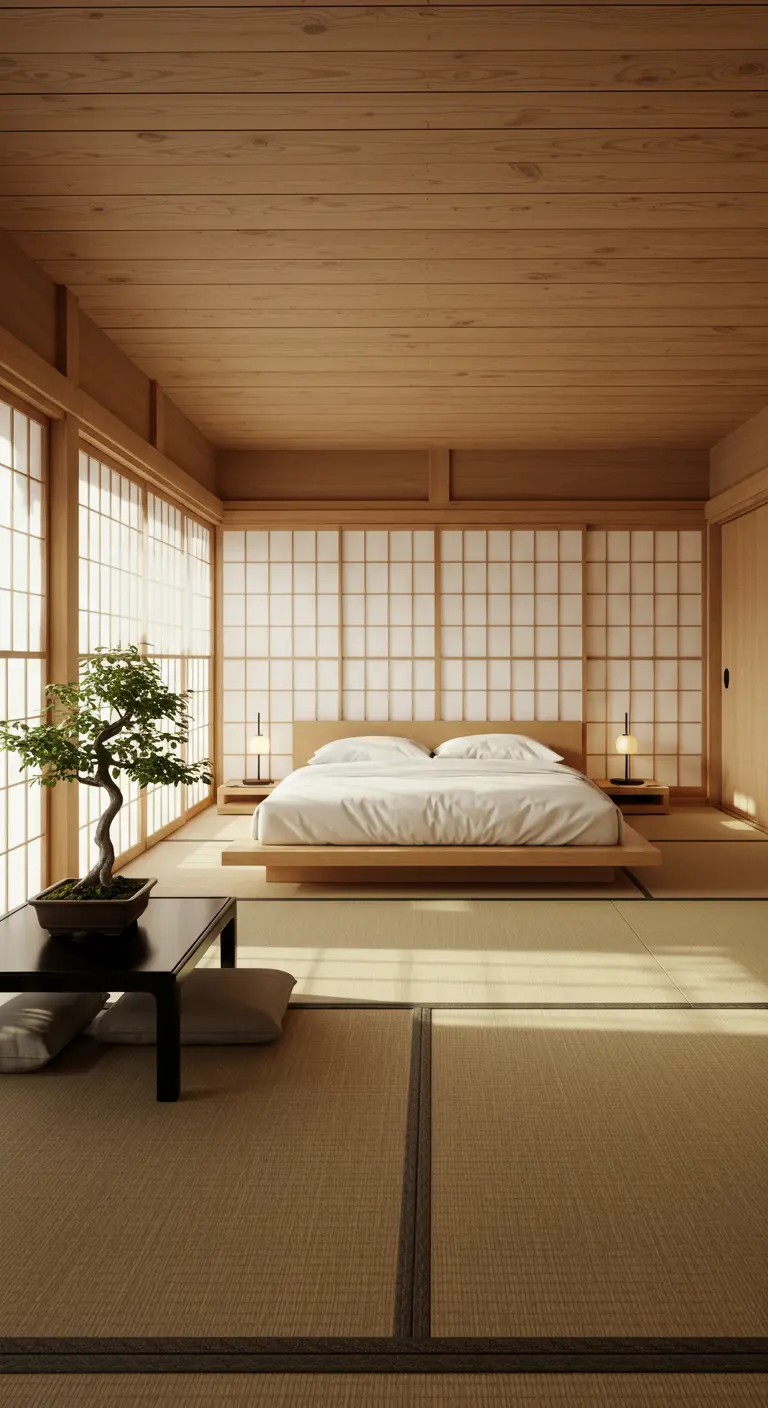
Build your serene space around a low-profile platform bed, which enhances the feeling of openness and stability in the room.
You don’t need a custom-built piece; many retailers offer simple, low frames in pale wood tones that achieve the same effect.
Keep bedding minimal with crisp, solid-colored linens, and introduce a single, living sculptural element like a bonsai tree to add organic form and focus.
If a bonsai feels too demanding, a single, carefully chosen branch in a simple ceramic vase offers a similar aesthetic with less maintenance.
2. Marry Urban Views with Organic Textures
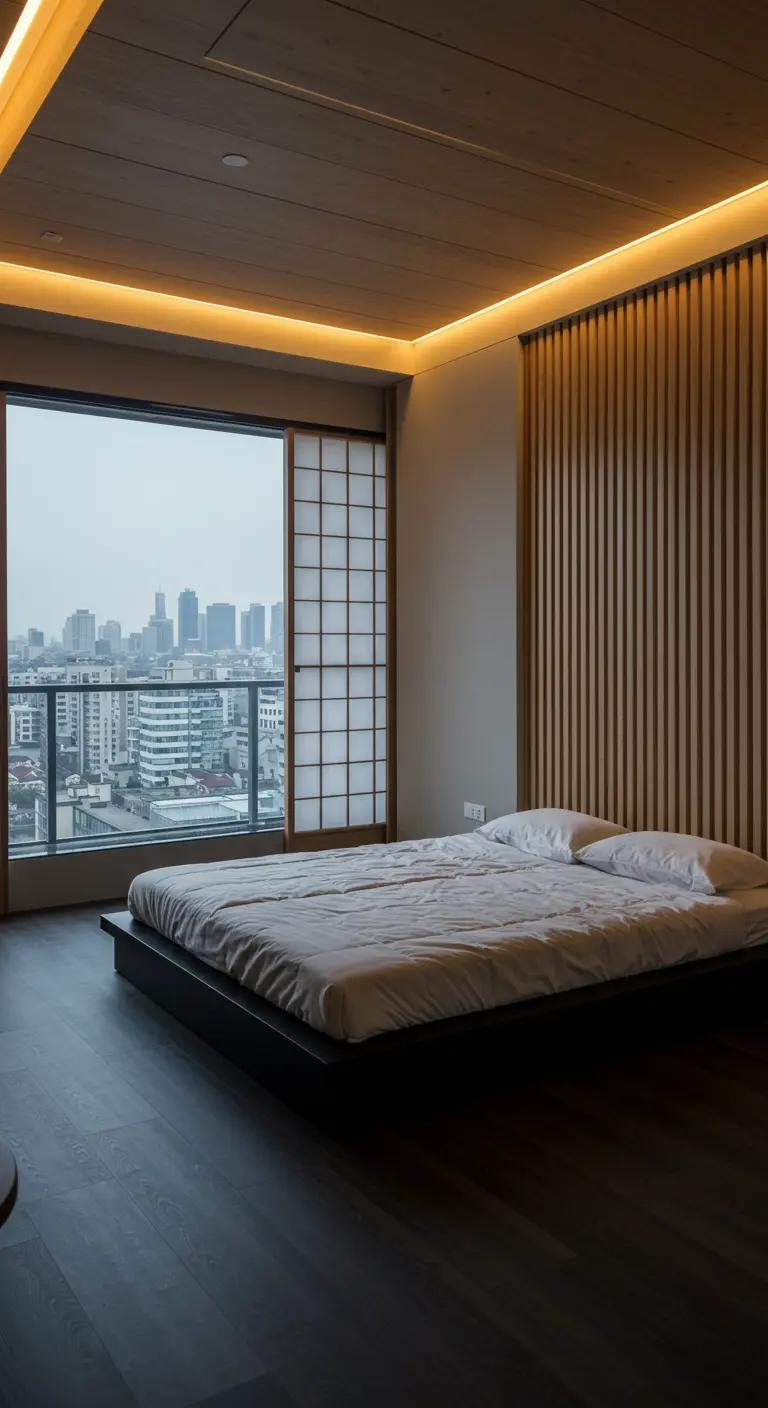
Balance a cool, modern cityscape by introducing warm, natural materials that ground the room.
A slatted wood accent wall adds vertical rhythm and incredible texture, preventing the space from feeling sterile.
Instead of harsh overhead lights, wash the ceiling in a gentle glow with indirect cove lighting, which creates a soft, calming ambiance perfect for a bedroom.
A dark wood floor anchors the space, making the light from the window—and the view—feel even more expansive and dramatic.
3. Dissolve the Barrier Between Inside and Out
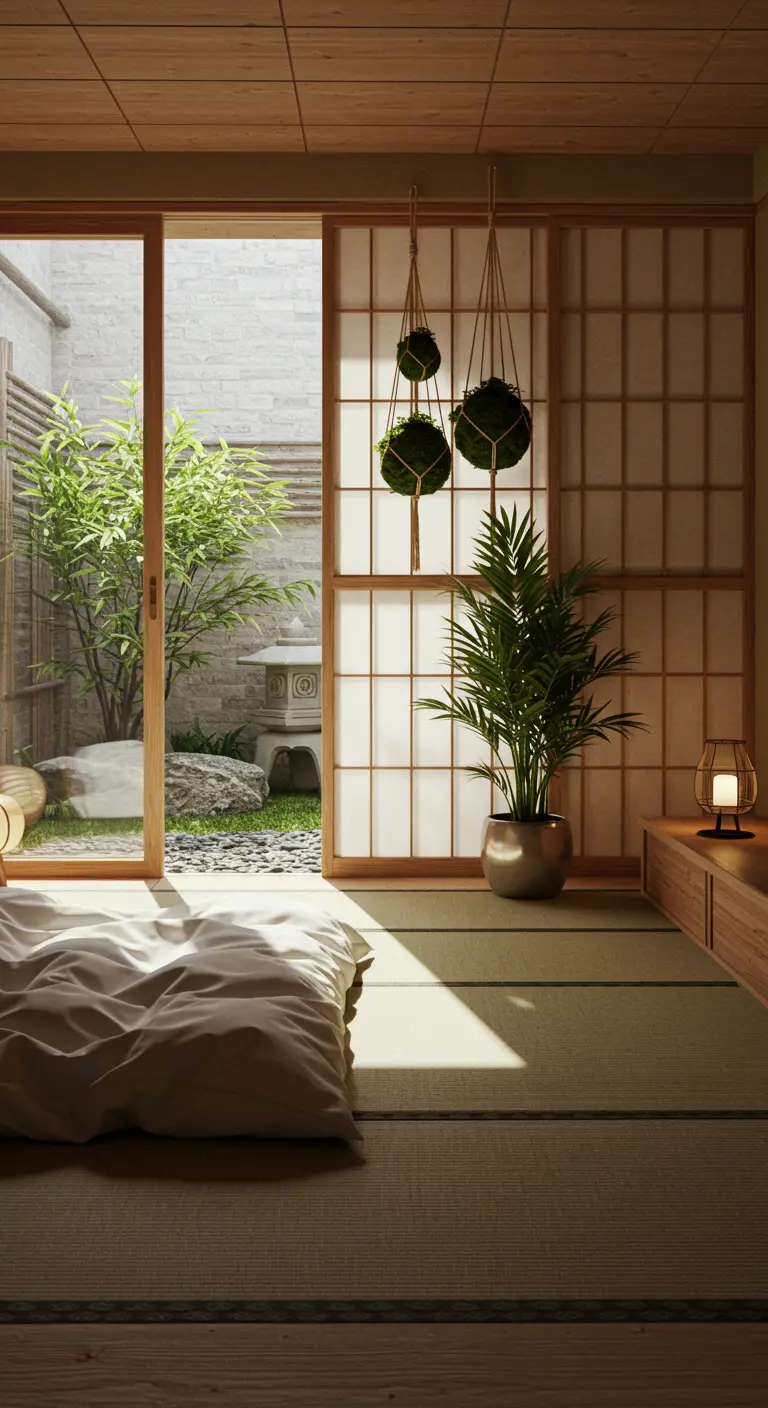
Use sliding shoji-style doors to fully connect your bedroom to a garden or patio, effectively creating one large, seamless space.
This design move not only brings nature’s calming influence indoors but also makes the room feel significantly larger.
Echo the outdoor elements inside with carefully chosen plants, like hanging kokedama or a potted palm, to strengthen the connection.
Even a tiny balcony can be transformed into a secret forest hideaway, blurring the lines between your home and the outdoors.
4. Cultivate Calm with Strategic Shadows
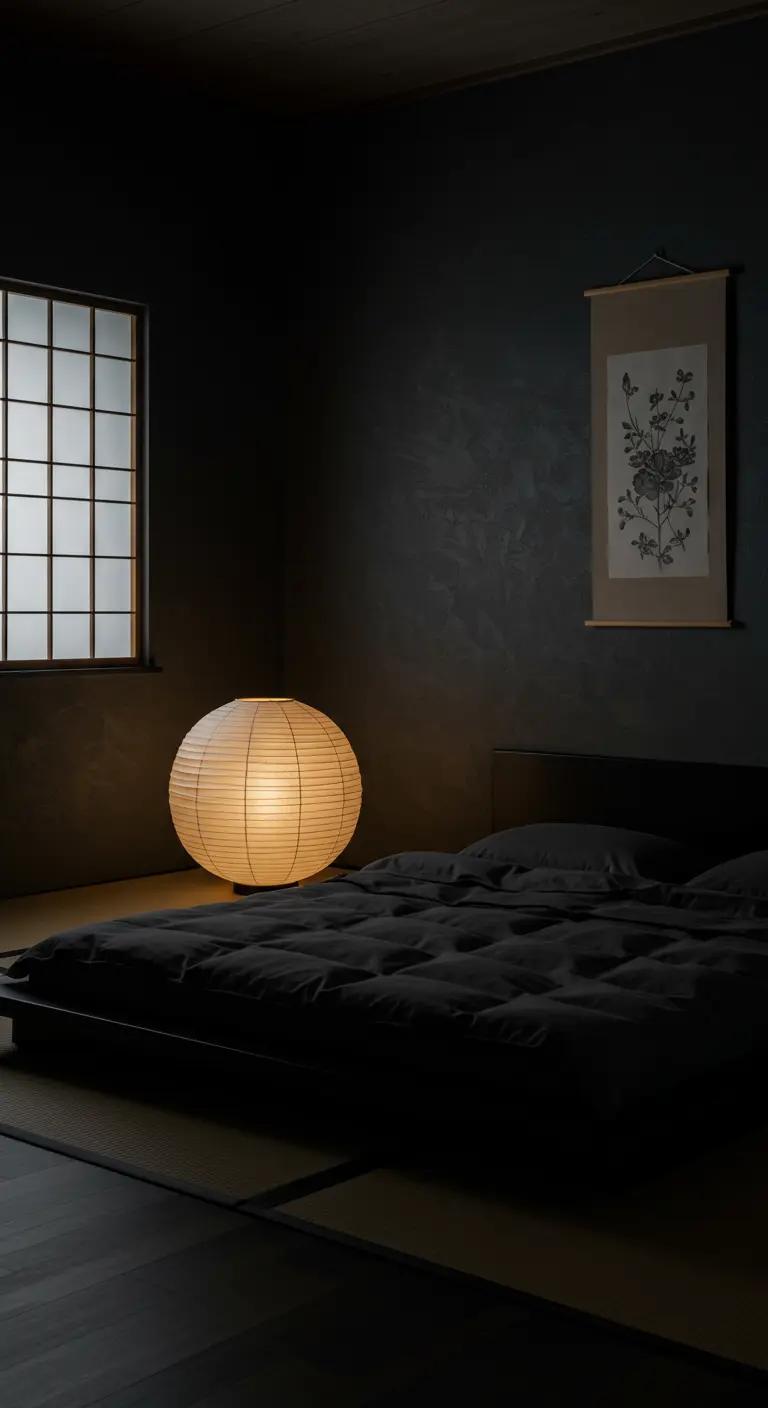
Don’t be afraid of using deep, moody wall colors to create a serene and enveloping atmosphere.
A dark charcoal or indigo fosters a cocooning effect that is ideal for promoting restful sleep.
The key is to treat light as a sculptural element: a single, oversized paper floor lantern provides a soft, diffuse glow that feels both warm and intentional.
This proves that minimalism is not just about white space, but about thoughtfully eliminating visual and mental clutter.
5. Find Beauty in Imperfect Textures
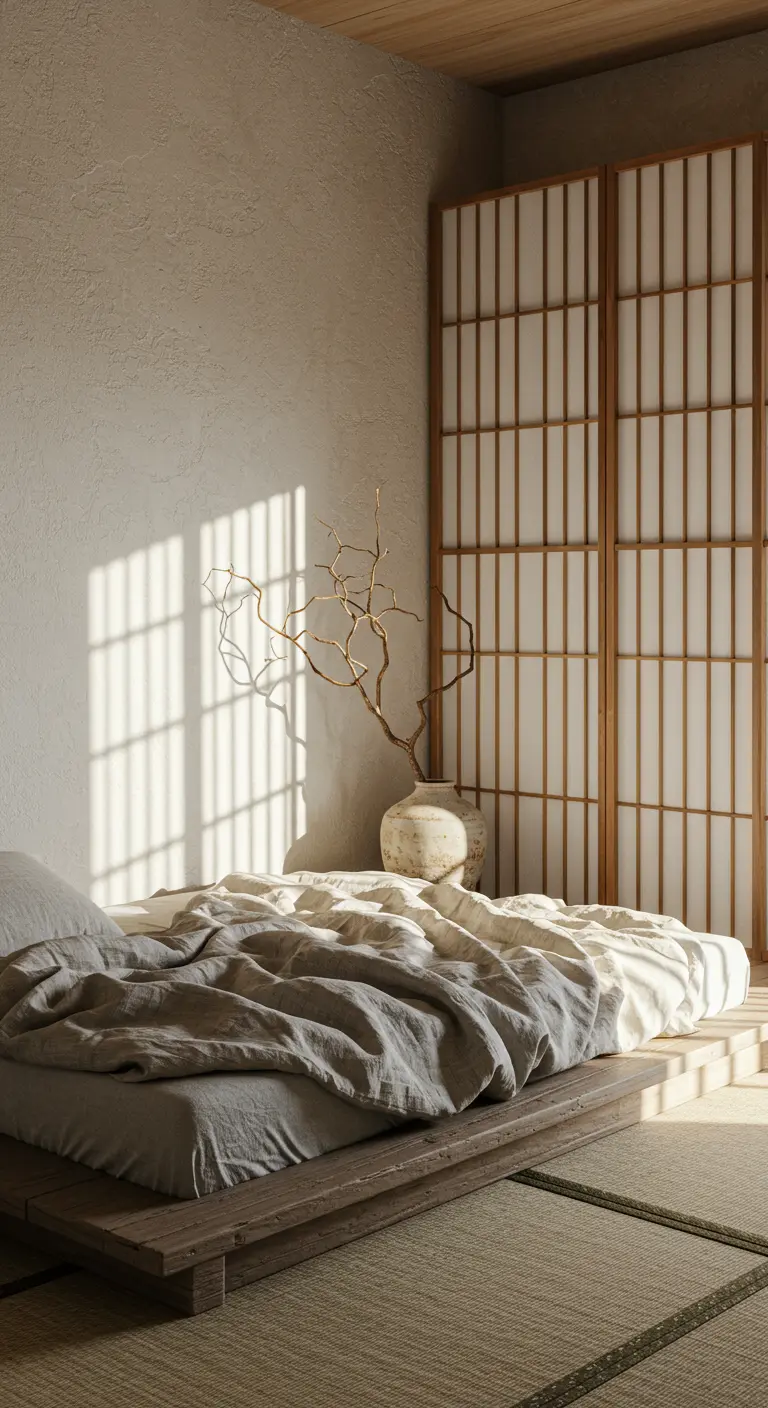
Embrace the core principle of wabi-sabi style spaces by choosing materials that celebrate natural texture and imperfection.
A hand-troweled plaster or limewash wall adds a remarkable depth and softness that beautifully interacts with natural light.
Pair this tactile surface with rumpled linen bedding and a sculptural dried branch in a rustic vase.
The goal isn’t to look messy, but to appreciate materials that feel authentic, lived-in, and deeply connected to the natural world.
6. Elevate Your Sleep Space with Integrated Storage

A raised platform bed is a brilliant way to incorporate storage while maintaining a clean, uncluttered aesthetic.
By building the bed on a tatami-topped dais, you create ample space for hidden drawers underneath, keeping floors clear.
This is a highly effective strategy for space-savvy small bedroom ideas, as it combines two essential functions into one footprint.
Complete the look with a single wall sconce, which provides focused light and eliminates the need for a bedside table.
7. Ground the Room with Dark, Reflective Floors
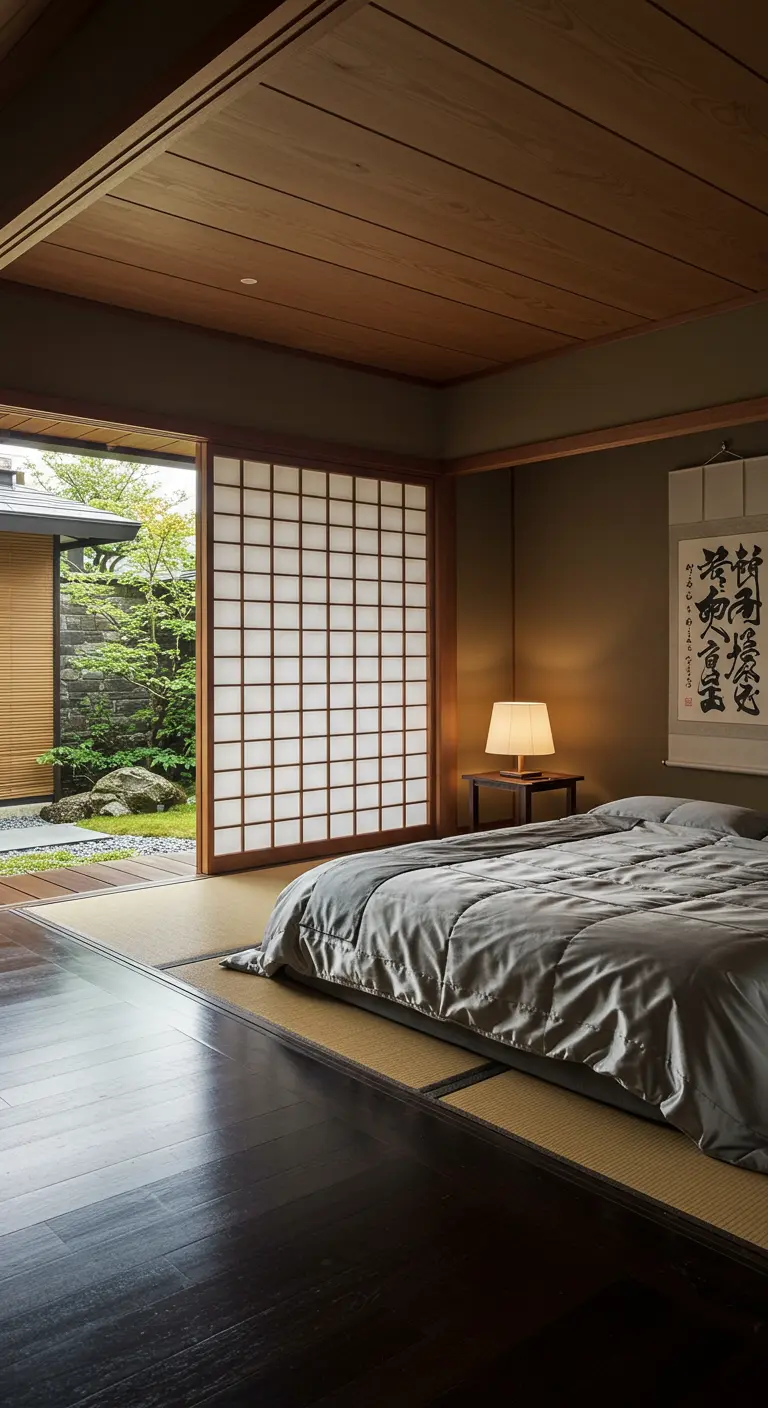
While light wood is a common choice, a dark, polished floor can introduce a feeling of profound depth and sophistication.
It beautifully reflects the soft, ambient light from lamps and shoji screens, creating an almost liquid quality in the room.
To prevent the dark tone from feeling overwhelming, use lighter tatami mats to define the sleeping area, which adds crucial textural and tonal contrast.
This dark foundation also makes any view of outdoor greenery appear even more lush and vibrant.
8. Frame Nature as Your Headboard
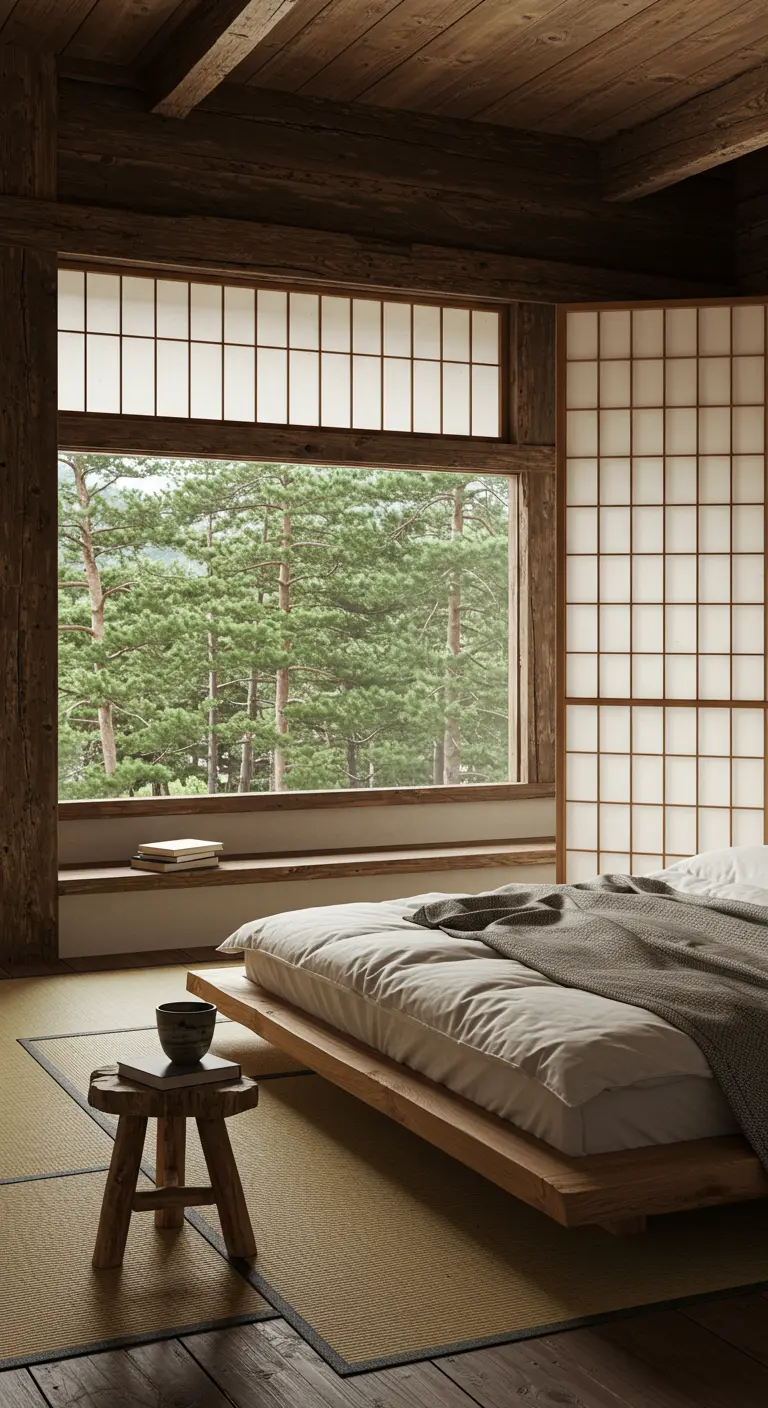
When your bedroom is blessed with a beautiful view, your design work is halfway done—simply make it the undisputed focal point.
Position your low-profile bed to directly face the window, transforming the landscape into a piece of living, ever-changing art.
Forgo a traditional headboard and keep wall decor to an absolute minimum to ensure nothing competes with the natural scene outside.
This philosophy of bringing the outside in is a hallmark of serene, modern rustic spaces.
9. Blend Japanese Minimalism with Scandinavian Warmth
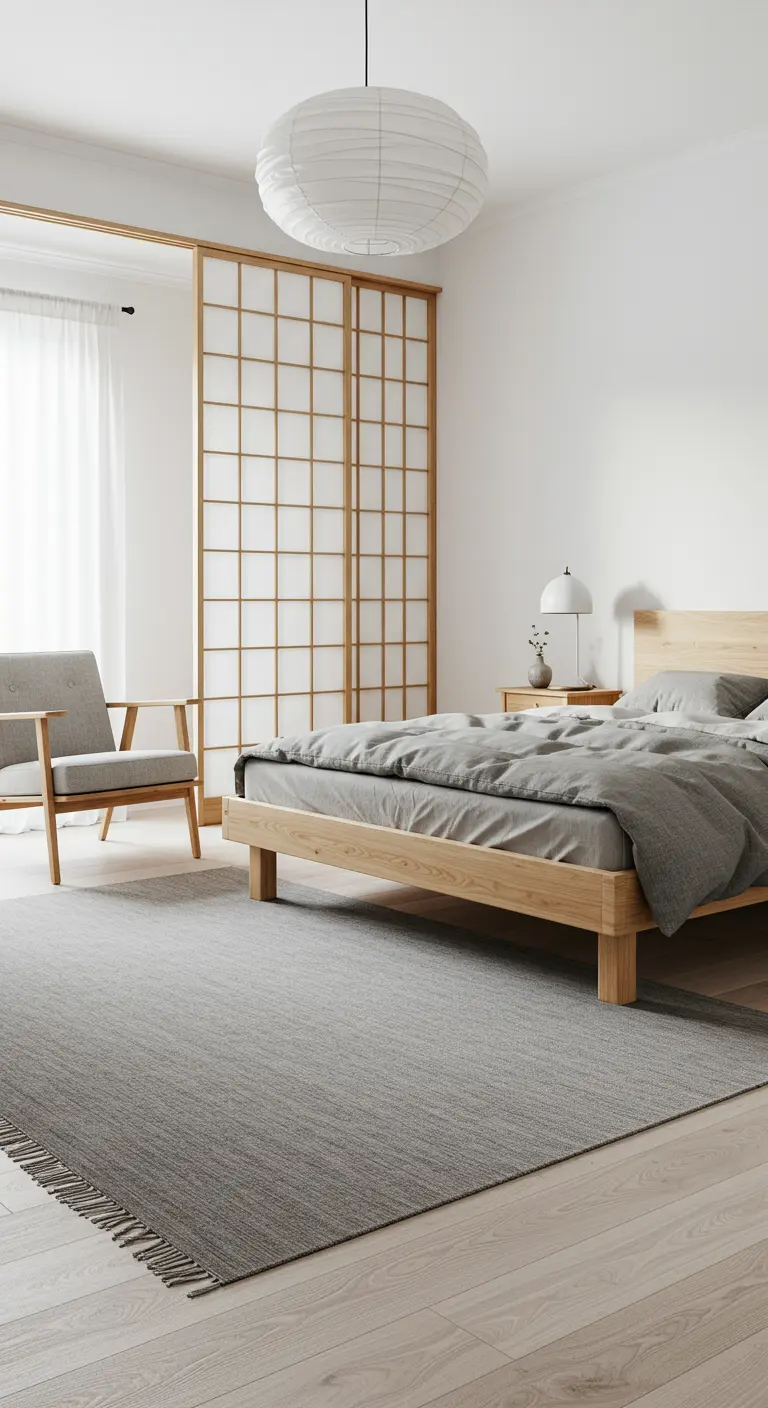
Discover the appeal of Japandi style, which masterfully blends Japanese minimalism with the cozy functionalism of Scandinavian design.
To achieve this look, pair a simple, light oak bed frame with soft, textured textiles like gray linen and a woven wool rug.
Use shoji-inspired sliding doors for closets to maintain the clean lines while providing practical storage.
A large paper lantern pendant acts as a sculptural focal point, unifying the two design philosophies with its soft, ambient light.
10. Distill the Bedroom to Its Purest Function
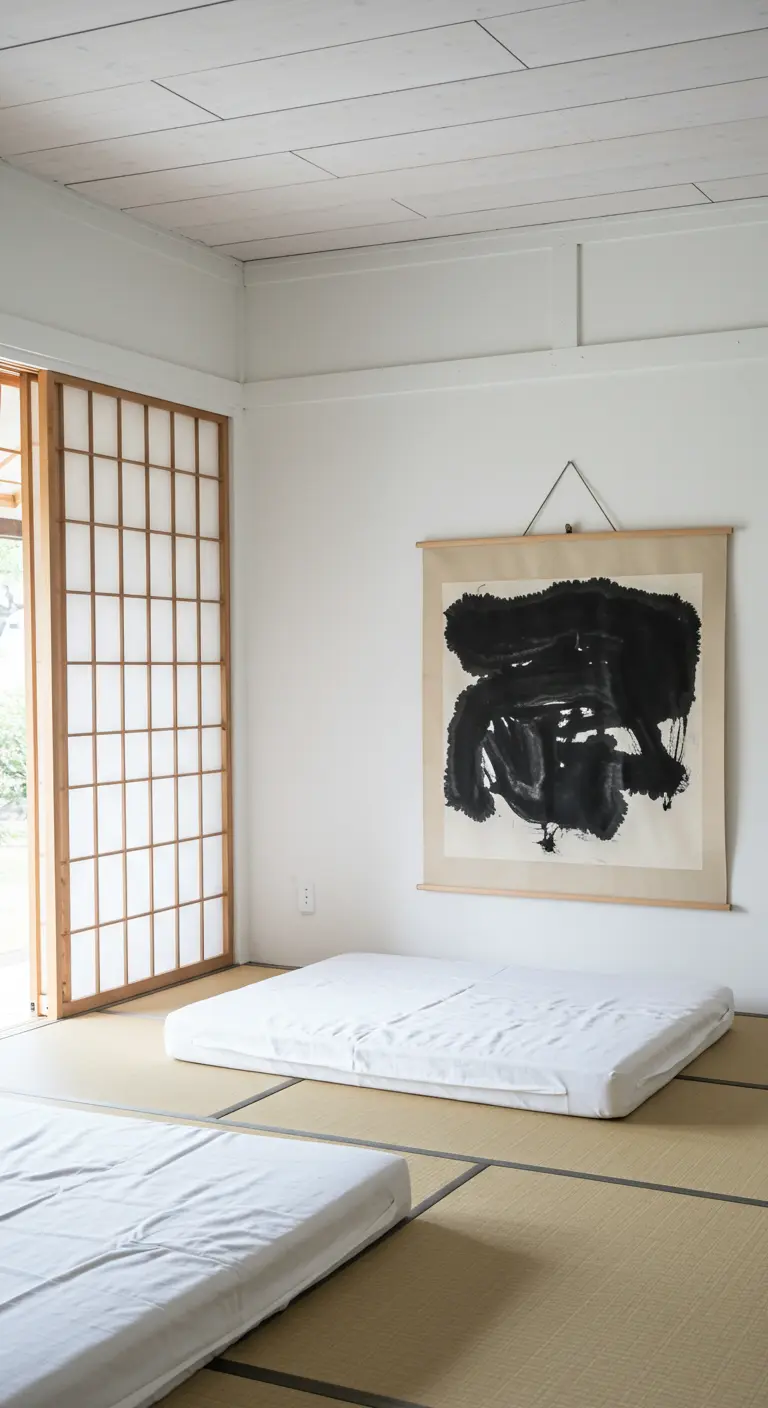
For the ultimate minimalist expression, pare your bedroom back to its most fundamental purpose: a serene place for rest.
A traditional shikibuton, or Japanese futon, placed directly on tatami mats can be rolled up and stored during the day, creating a flexible, multi-purpose room.
With such simplicity, the only adornment needed is a single, impactful piece of art, like a bold calligraphic scroll.
This commitment to negative space is what makes minimalist interiors feel so deeply restorative and peaceful.
11. Design a Dedicated Zone for Morning Rituals
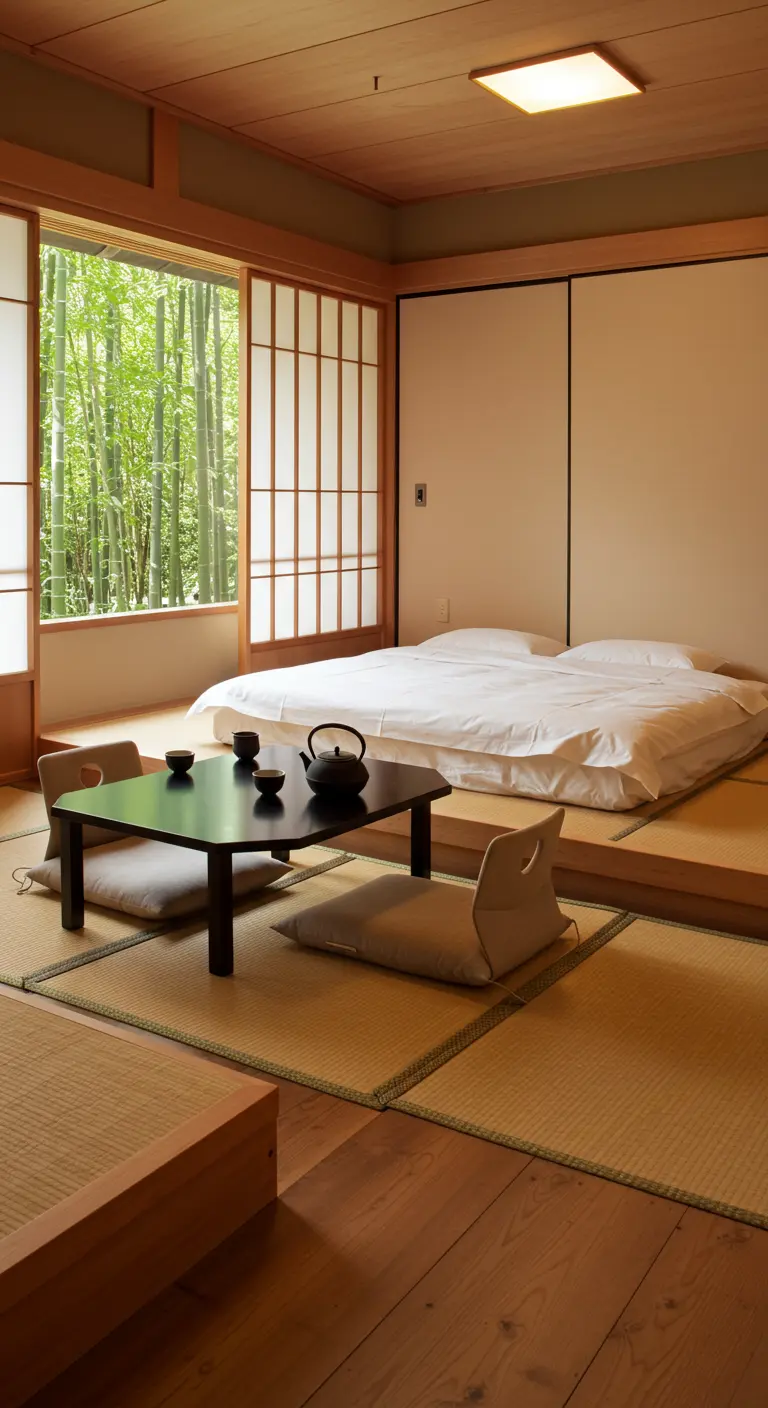
Integrate a space for quiet reflection directly into your bedroom layout to encourage mindful moments.
Place a low table and floor cushions near a window to create an intentional zone for enjoying tea or meditating as you start your day.
This simple act of zoning separates the function of sleep from the ritual of quiet contemplation, adding another layer of purpose to your sanctuary.
A view of a bamboo grove or a simple garden further enhances the feeling of a private retreat.
12. Maximize Vertical Space with a Lofted Bed
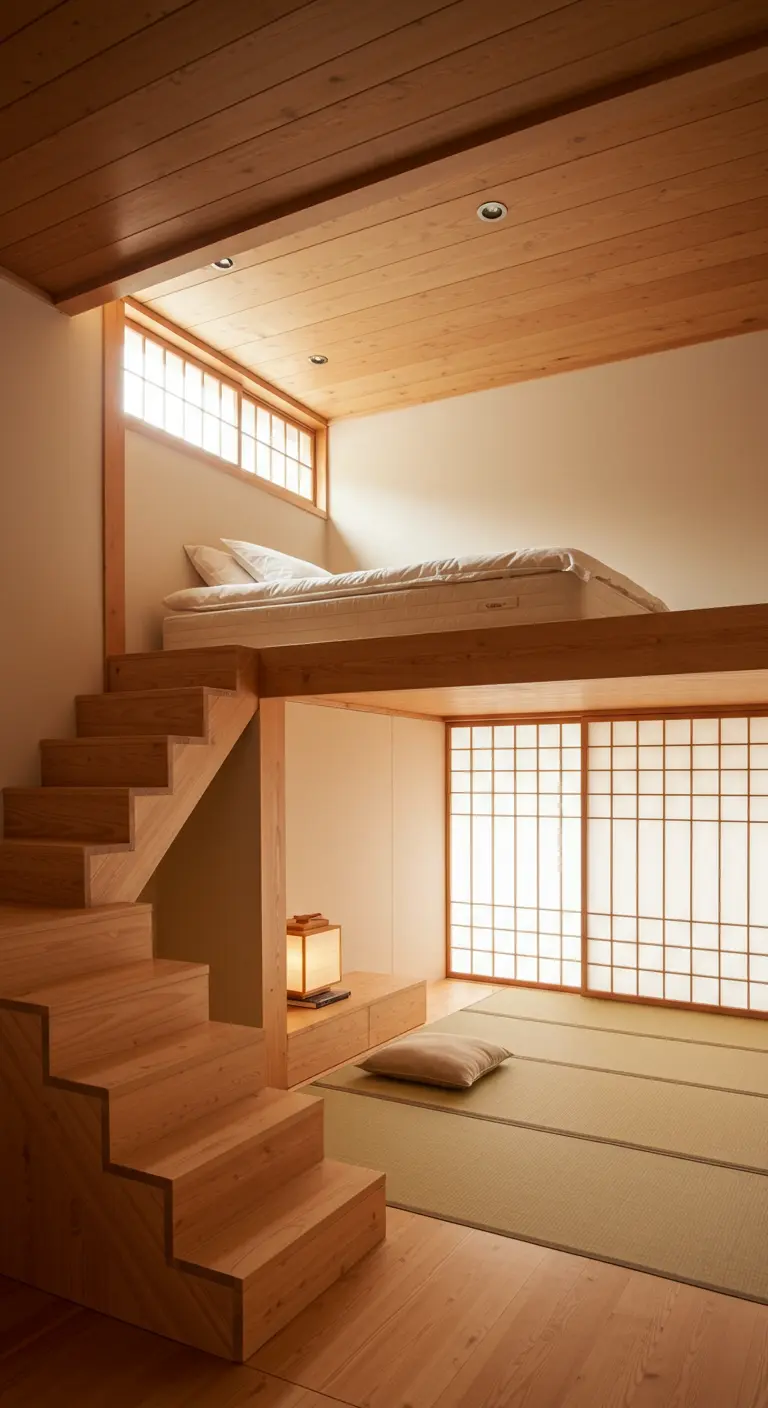
In a room with high ceilings but a small footprint, thinking vertically is the key to maximizing your space.
A lofted bed frees up the entire floor area below for another use, such as a tatami-matted meditation nook or a compact workspace.
The staircase itself becomes a strong, sculptural element in the room’s design.
This layout is a clever way to zone a space, a strategy often used in studio apartment designs to create distinct living areas.
13. Introduce Warmth Through an Earth-Tone Palette
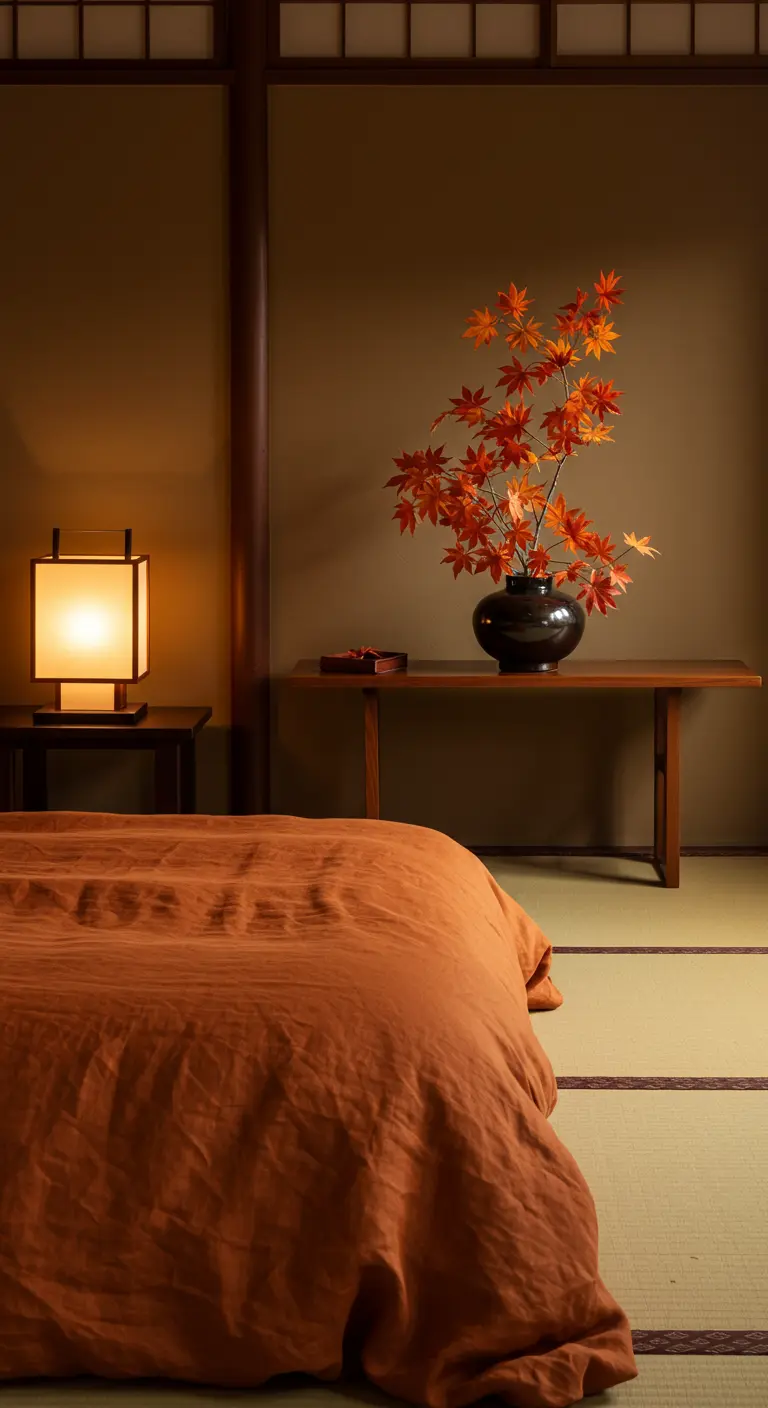
Shift away from cool grays and whites toward a palette of warm, earthy tones to create a cozier and more grounding atmosphere.
A duvet cover in a rich terracotta, rust, or ochre shade adds instant warmth and sophistication.
Complement these hues with dark wood furniture and an ikebana-style arrangement of seasonal branches—here, vibrant autumn maple leaves.
The result is a space that feels deeply connected to nature and the changing seasons, like these inviting warm earth-tone rooms.
14. Create an Intimate Nook with a Sunken Bed

For a truly unique and enveloping sleep experience, consider designing a sunken bed recessed into the floor.
This architectural choice creates an incredibly intimate, nest-like feeling that separates the sleep zone from the rest of the room.
Amplify the effect with hidden LED strip lighting installed around the base, which casts a soft, upward glow and makes the bed appear to float.
This turns the bed into the undeniable heart of the room—a private sanctuary within your sanctuary.
15. Use a Single, Bold Color with Intention
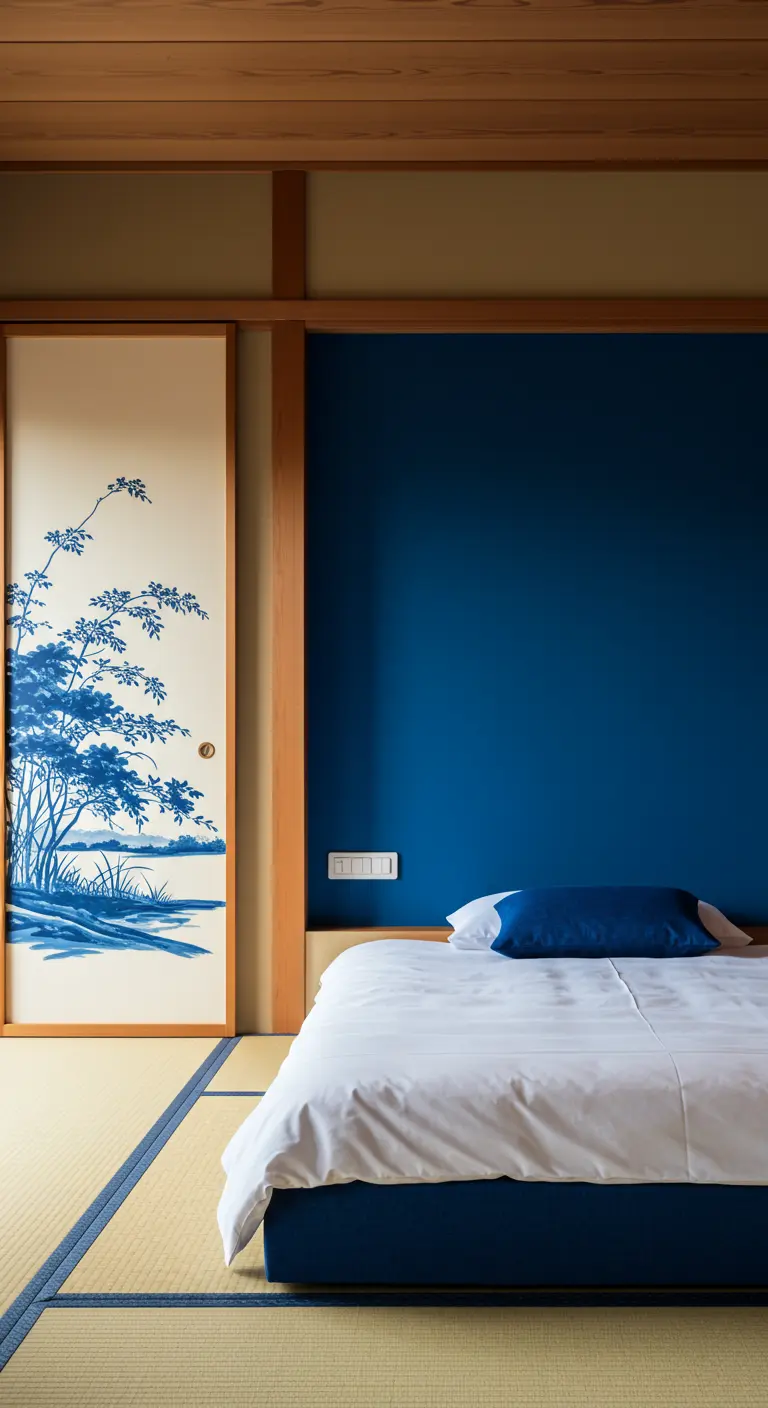
A minimalist aesthetic does not require a complete absence of color; it simply demands that color be used with clear intention.
Choose one deep, saturated hue, like this rich indigo, and apply it strategically to an accent wall.
This provides a strong, grounding backdrop without overwhelming the space.
Echo the color in a single detail, such as a throw pillow or a beautifully painted closet door (fusuma), to create a confident and cohesive design statement.
16. Turn Shoji Screens into Architectural Light Fixtures
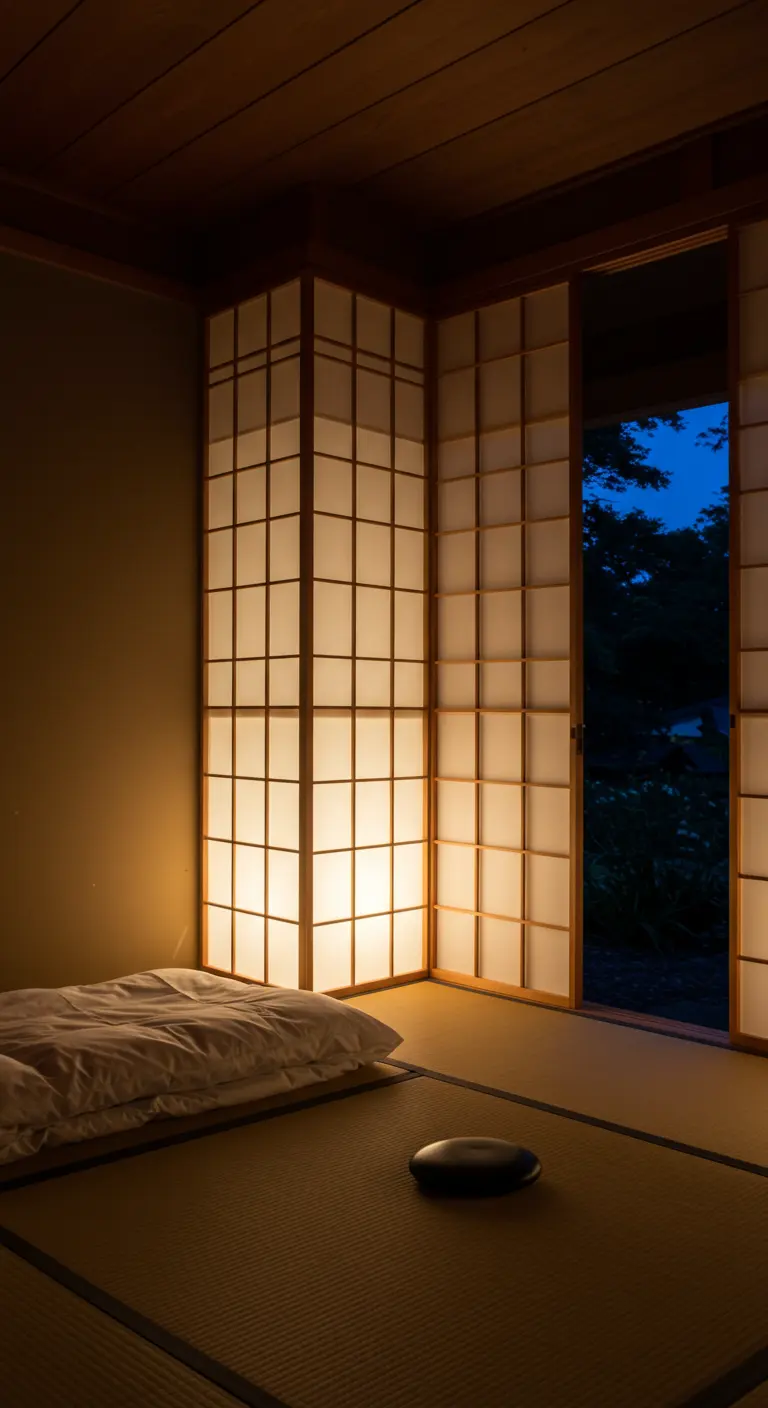
Instead of thinking of shoji screens as mere doors or partitions, consider their potential as large-scale, ambient light sources.
By installing lighting behind a shoji panel, you can transform it into a glowing architectural feature.
Here, a corner installation is backlit to create a stunning, lantern-like effect that washes the room in soft, diffuse light.
This technique eliminates harsh shadows and fosters a profoundly peaceful atmosphere, ideal for winding down at the end of the day.
17. Connect Visually with a Calming Water Feature
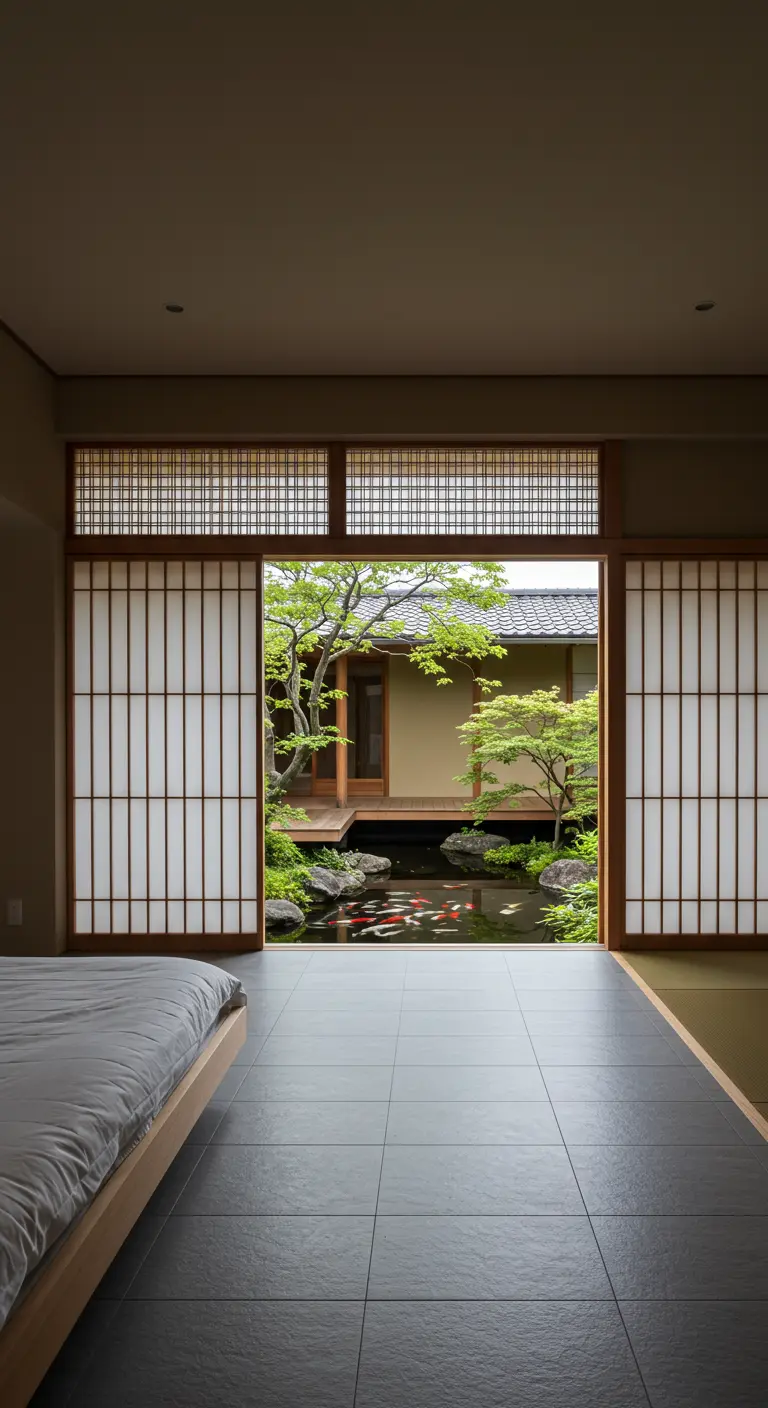
If you have a garden with a water element, design your room to make it an integral part of your daily experience.
Large, sliding glass or shoji doors that frame a view of a koi pond create a powerful sense of tranquility and movement.
Choose an interior flooring material like cool slate tile, which provides a seamless visual transition to the stone and water outside.
This strengthens the feeling of being in a private zen garden retreat.
18. Find Order and Calm in Symmetry

Create an immediate sense of visual balance and order by employing symmetry in your bedroom layout.
A perfectly centered bed flanked by two identical bedside tables and matching lamps is an inherently calming arrangement.
A large shoji screen positioned behind the bed serves as a serene, graphic headboard, further reinforcing the room’s peaceful equilibrium.
This classic design principle is one of the easiest ways to make a space feel resolved and harmonious.
19. Fuse Japanese Zen with an Industrial Edge
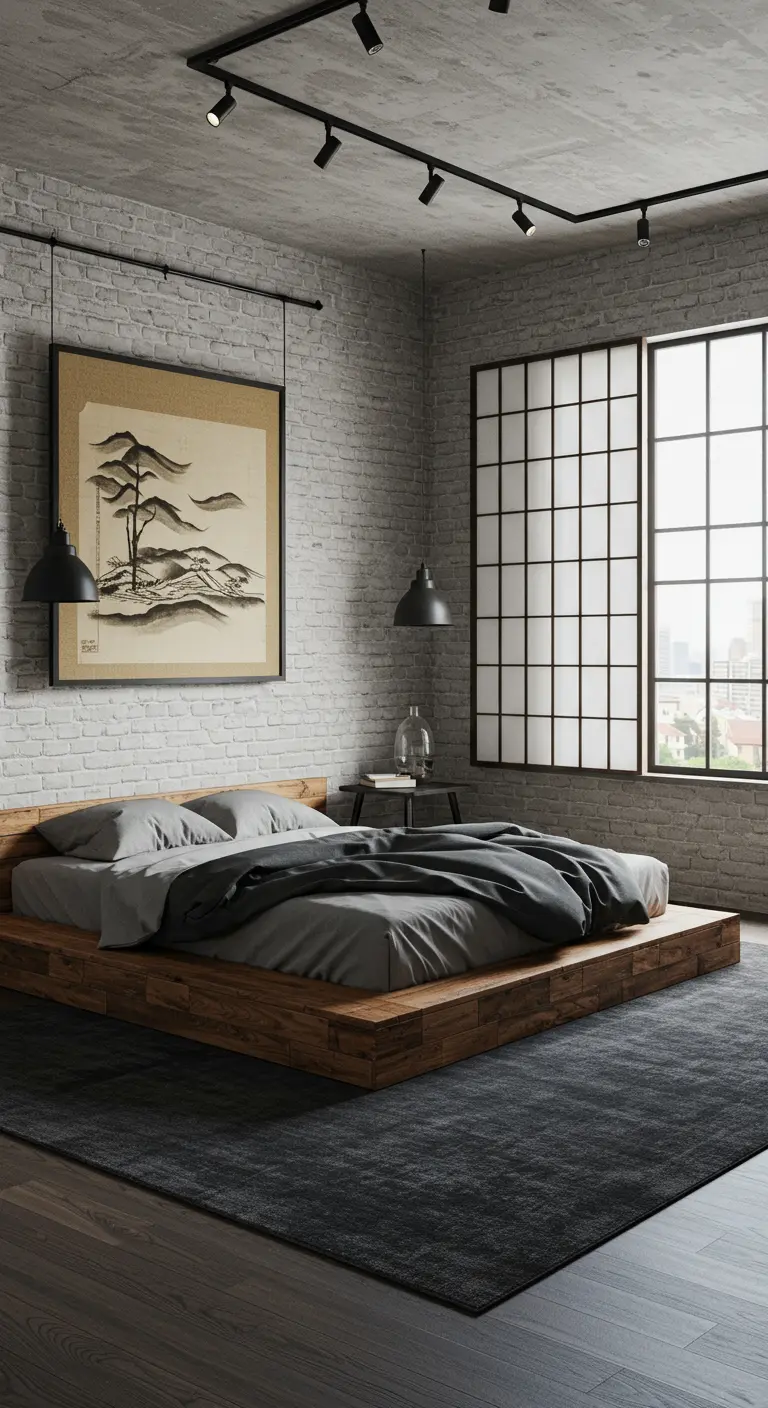
Create a compelling dialogue between two distinct styles by blending the rawness of industrial design with the serenity of Japanese aesthetics.
Juxtapose a textured brick wall with the clean lines of a sleek, low-profile wooden bed.
Use black as a unifying accent—in track lighting, window frames, and textiles—to tie the two looks together.
Finally, a large, minimalist piece of ink-wash art anchors the room in a zen mindset, softening the harder edges of the industrial elements.
20. Introduce Softness with a Touch of Sakura Pink

A minimalist palette can feel warm and inviting with the addition of subtle, romantic details.
A single silk or linen throw in a delicate sakura pink adds a whisper of color and a touch of luxurious texture.
Pair this with a graceful arrangement of cherry blossom branches in a simple glass vase to evoke the ephemeral beauty of spring.
This is a gentle way to introduce a softer, more celebratory note without disrupting the room’s overarching sense of calm.
21. Carve Out a Dedicated Space for Stillness

Designate a small corner of your bedroom specifically for mindfulness practices to encourage daily use.
A circular mat helps to visually define the area, making it feel like a special, consecrated space.
All you truly need is a comfortable floor cushion (a zabuton), an incense holder, and perhaps a singing bowl or a candle.
By creating this intentional zone, you transform your bedroom from just a place to sleep into a true sanctuary for both mind and body.
22. Redefine the Canopy with a Minimalist Frame
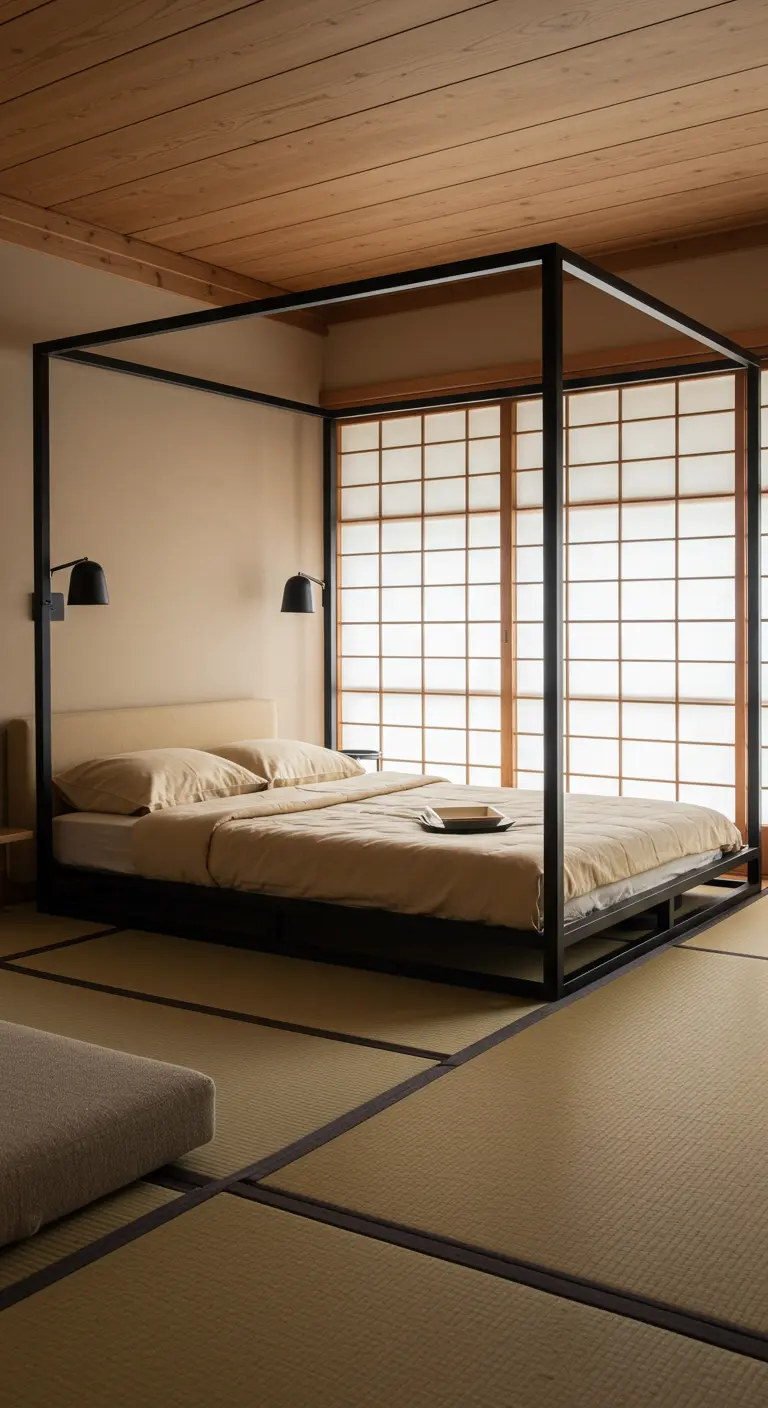
A four-poster bed can feel surprisingly modern and airy when you reduce it to its essential architectural form.
A simple, thin metal frame creates the intimate feeling of an enclosure without any of the visual weight or fuss of traditional drapery.
This structure adds height and interest while maintaining an open, minimalist aesthetic.
Install wall-mounted sconces inside the frame to provide focused reading light, enhancing the feeling of a cozy room within a room.
23. Let One Powerful Artwork Set the Tone
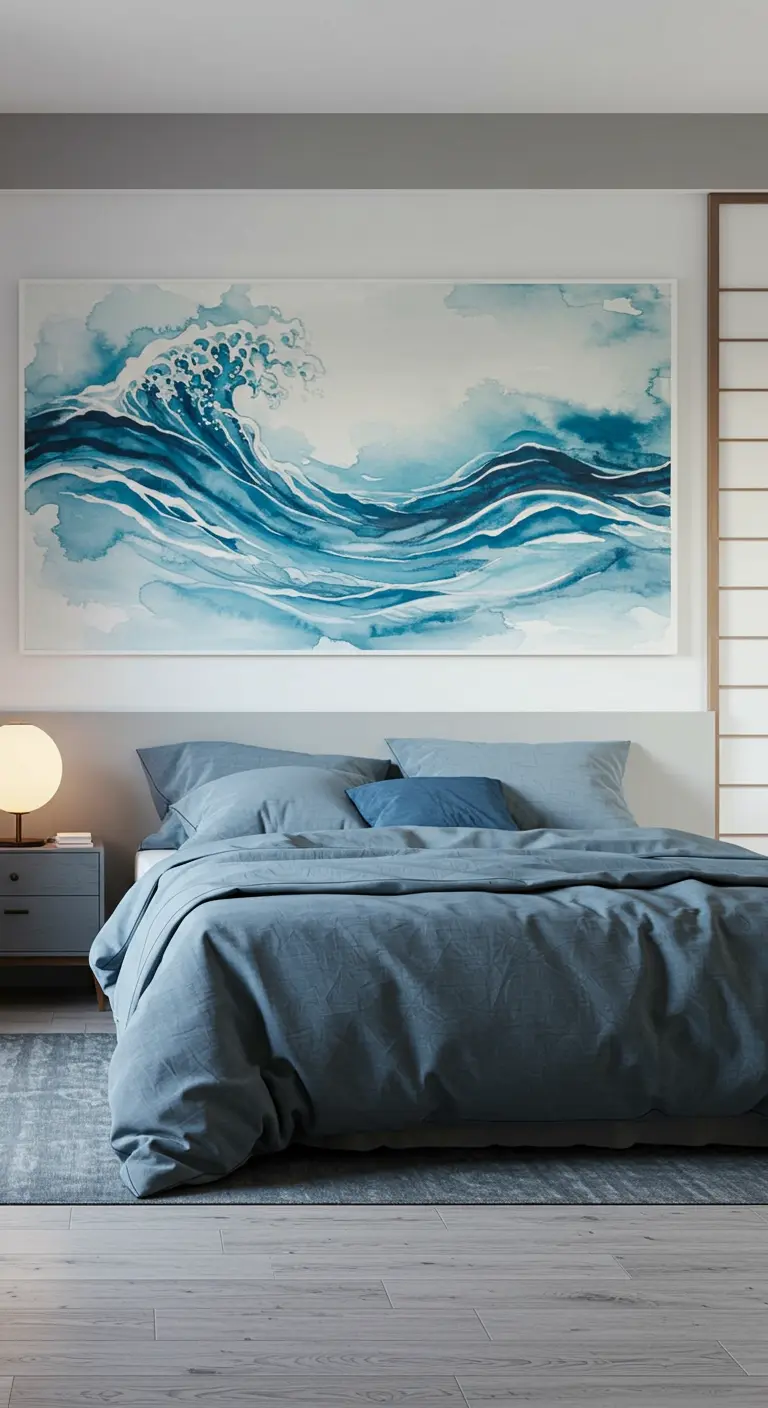
Instead of filling your walls with multiple small pieces, choose one oversized work of art that captures the exact mood you wish to cultivate.
Here, a dynamic watercolor painting of ocean waves provides both a color palette and a sense of powerful, natural energy.
Pull hues from the artwork for your bedding—like these soft, misty blue-grays—to create a sophisticated and cohesive, art-led design.
This ensures your room has a clear and impactful focal point that tells a single, compelling story.
